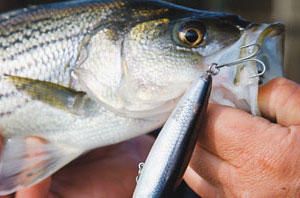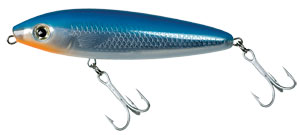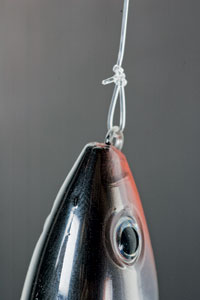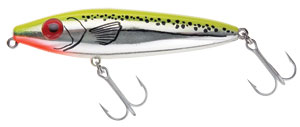2. Leader Out
Another effective yet often overlooked trick '� particularly in clear water '� is keeping your leader out of the water. Again, when fish are off their feed, going with a smaller diameter, lighter leader is a basic adaptation. However, it's even more effective if most of that leader rides out of the water.
In the Neuse and Trent rivers, we were getting quite a few followers and last-second turn-aways. Granted, the water there is far from clear, but these followers had plenty of time to investigate our lures. And, initially, something was keeping them from striking.
I began making long casts and holding my rod tip high over my head while imparting short twitches to create a tight walk-the-dog action. By holding the rod high, I kept most of that 25-pound-test leader out of the water. The strikes started coming, and I believe my tactic had a lot to do with it.
3. Hit the Throttles
When fish are reluctant to strike, try teasing the followers by increasing retrieval speed as soon as you see them behind the lure. When fish are striking with abandon, keep to your original retrieve; it is when strikes are slow in coming that this trick shines.
Think about it. If you were a fish that had just charged up behind a lure, and that lure just kept twitching along with no appreciable difference in action, wouldn't you think something was amiss? In nature, that fleeing baitfish should sense a predator fish coming at it, and the realization that it is just seconds from doom should prompt it to panic. The ensuing change in speed and distress vibrations are what often prompts a game fish into striking, triggering its natural instincts to prey on this weak link '� hungry or not.
On several occasions, we sped up our lures when fish appeared behind them to create the illusion of their trying to outrun the fish. Between that tease and keeping most of the leader out of the water, several followers were converted into releases.
5. Hit the Brakes
One of Dubiel's favorite tricks is to pause his topwater plug. There are occasions, especially during feeding blitzes, when fish refuse to strike a rapidly moving plug. Perhaps the fish become programmed to consume the injured ones that can't swim off? Fish that aren't especially aggressive sometimes want an easier target, like a severely injured bait that is barely kicking.
I watched Dubiel convert many a fish by occasionally pausing his lure for a few seconds before picking up the retrieve and pausing the lure again for a few more seconds. This tactic worked well when he pitched a lure right into the blitz, where you would think any quickly fleeing lure would draw strikes.





